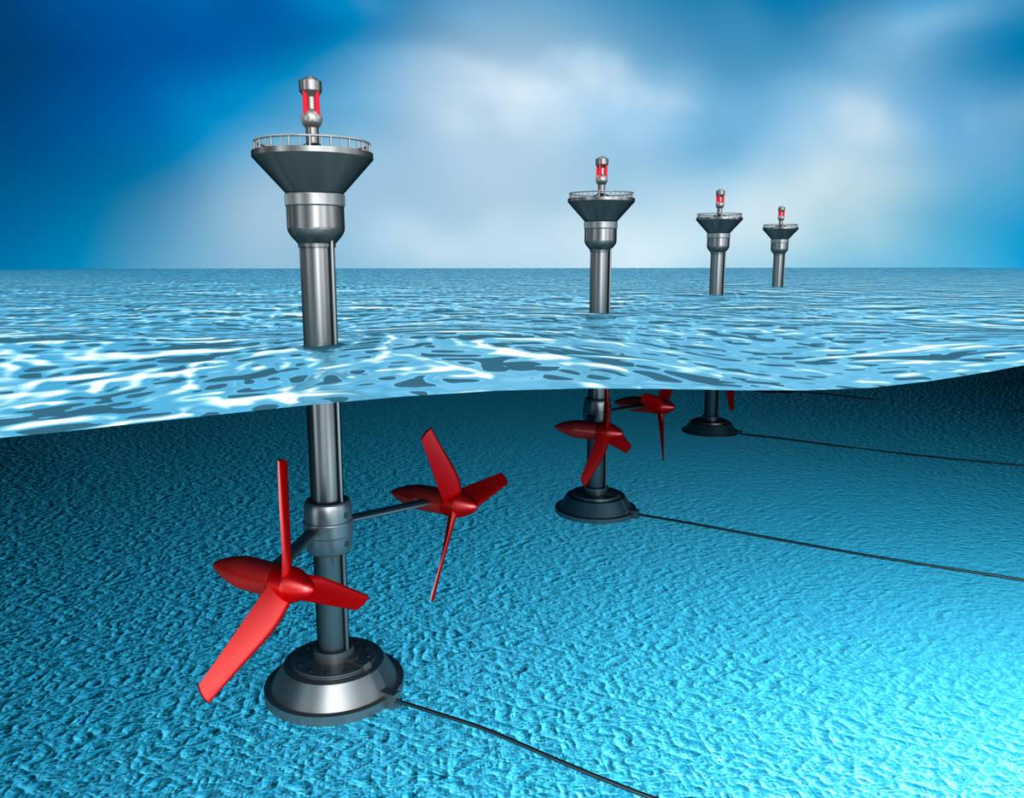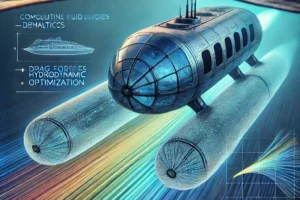Utilizing the tides of the ocean has emerged as a promising frontier in the renewable energy industry as an ocean power generation method in the search for sustainable and environmentally friendly energy solutions. Taming the tides to produce clean energy offers a beacon of hope as the world struggles with the effects of climate change and works to lessen its reliance on fossil fuels. In this article, we explore the fascinating world of tidal energy and examine how it might completely alter the supply of renewable energy.
Understanding Tidal Energy
Ocean power energy or Tidal energy is a type of renewable energy that produces electricity by utilizing the normal rise and fall of ocean tides. Tidal energy is a dependable and stable source of power because it is highly predictable and constant, unlike solar and wind energy. The procedure entails positioning underwater turbines or tidal stream generators in advantageous locations where tidal currents are strong, such as narrow straits or channels between islands.
Making use of the gravitational pull of the sun and moon, tidal energy is produced. Every day the moon’s gravitational pull causes two high tides and two low tides while the sun’s gravitational pull is of much lesser extent. Tidal changes cause water to move, creating kinetic energy that can be used to generate electrical energy with the right tools.

The Power of Tidal Energy
The power of tidal energy stems from its unique characteristics and advantages that set it apart from other renewable energy sources like solar and wind power.
Consistency and Predictability:
One of the most significant advantages of tidal energy is its consistency. Unlike solar and wind energy, which rely on weather conditions, tidal energy is entirely predictable and follows a regular cycle. The rise and fall of tides are mainly influenced by the gravitational forces of the moon and, the sun. These forces result in high tides and low tides every day, occurring with considerable regularity.
This allows for accurate forecasting of energy production, which makes it easier to bring tidal power into the electricity grid. Energy utilities can plan and manage the supply more efficiently, thereby reducing the need for expensive energy storage systems that are required.
Minimal Environmental Impact:
Another aspect of tidal energy is its minimal environmental impact. Unlike conventional fossil fuel power plants, tidal energy does not produce greenhouse gases, which are major contributors to global warming. By utilizing the natural movement of tides, we can generate electricity without adding to the climate change, making it a cleaner and greener alternative to fossil fuels.
Since no harmful pollutants like sulfur dioxide, nitrogen oxides, or particulates are released, tidal energy has little effect on the quality of the air. In urban areas where traditional power plants’ air pollution poses serious health risks, this is especially crucial.
Moreover, the technology’s impact on marine life is carefully studied and managed to ensure the preservation of marine ecosystems. Proper siting and environmental assessments are conducted before constructing tidal energy facilities to minimize disturbances to marine habitats and wildlife.
Long Lifespan and Low Operational Costs:
Tidal energy projects often have a long operational lifespan, typically lasting for several decades. This longevity is due to the durable nature of the infrastructure, which is designed to withstand harsh marine conditions. The turbines and other components are engineered to be corrosion-resistant and robust, ensuring continuous operation for extended periods.
The extended lifespan adds to the appeal of tidal energy, as it leads to reduced maintenance and operational costs over time. Once the infrastructure is in place, ongoing maintenance requirements are relatively low compared to other renewable energy sources, such as wind turbines that require periodic maintenance and blade replacements.

Potential Challenges and Future Prospects:
Despite these advantages, tidal energy still faces certain challenges, such as high initial capital costs and limited suitable locations for large-scale projects. The construction of tidal barrages may also have environmental implications, altering estuarine ecosystems and migratory patterns of marine species.
However, ongoing research and development efforts are continuously improving tidal energy technologies, making them more cost-effective and efficient. Innovations in turbine design, material engineering, and resource assessment are paving the way for a brighter future for tidal energy.
In conclusion, the power of tidal energy lies in its consistency, minimal environmental impact, long lifespan, and potential to revolutionize the renewable energy landscape. As we invest in sustainable energy sources to combat climate change and move towards a greener future, tidal energy holds immense promise as a clean and reliable source of electricity.
Harnessing Tidal Energy
There are two primary methods of harnessing tidal energy: tidal range and tidal stream systems.
Tidal Range Systems:
Tidal range systems, also known as tidal barrages or tidal dams, harness the potential energy created by the difference in water level between high and low tides. The basic principle behind tidal range systems involves constructing a barrier, such as a barrage or a dam, across an estuary or bay. During high tide, water from the ocean enters the basin, and when the tide recedes, the trapped water is released back into the sea.
The tidal flow creates a significant water level difference between the two sides of the barrier, leading to the formation of a tidal head or a head of water. This tidal head represents the potential energy stored in the elevated water level. To convert this potential energy into electricity, the tidal range system uses specialized equipment, such as turbines.
As the tidal head is released through turbines, it flows from the high side to the low side, driving the turbines and generating electrical power. This back-and-forth movement of water causes the turbines to rotate, which in turn drives generators to produce electricity.
Tidal range systems have been in use for several decades, with some of the earliest projects dating back to the 1960s. The La Rance Tidal Power Plant in France, commissioned in 1966, is one of the pioneering tidal range projects and continues to provide a reliable source of renewable energy.
One of the advantages of tidal range systems is their predictability and stability. The tides are highly influenced by the gravitational forces of the moon and the sun, resulting in a regular and consistent pattern. As a result, tidal range systems can provide a reliable and steady source of electricity, making them suitable for base load power generation.
However, tidal range systems face some challenges, including high initial capital costs, limited suitable sites, and potential environmental impacts. The construction of tidal barrages can alter the natural flow of estuaries and affect local ecosystems. As a result, extensive environmental assessments and mitigation measures are necessary to ensure minimal disruption to marine habitats.

Tidal Stream Systems:
Tidal stream systems, also referred to as tidal current systems or marine current turbines, use the motion of tidal currents to generate energy. Tidal stream turbines work similarly to wind turbines in that they transform mechanical energy—in this case, the kinetic energy of tidal currents—into electrical power.
On the ocean floor, tidal stream systems are set up, with the underwater turbines placed in the way of powerful tidal currents. The turbines’ blades are moved by the tidal currents as the tides rise and fall, which causes them to rotate. Generators are powered by the turbines’ rotation, which turns mechanical energy into electricity.
The ability of tidal stream systems to adapt to various tidal patterns and locations is one of their main advantages. Tidal stream systems can be installed anywhere along a coastline where there are strong tidal currents, unlike tidal range systems, which need specific geographic features like estuaries or bays. Compared to tidal range systems, tidal stream systems are thought to be less disruptive to the environment. They leave a smaller physical mark than tidal barrages and typically do not interfere with the natural flow of water. They consequently frequently have less of an effect on marine ecosystems. However, tidal stream systems encounter difficulties with regard to technological advancement, upkeep in harsh marine environments, and the possibility of encounters with marine life. To maximize the energy output and operational efficiency, the underwater turbines must be guaranteed to be long-lasting and reliable.
Challenges and Opportunities
Tidal energy has a lot of potential, but there are still certain obstacles to be solved. Finding suitable places for the best energy generation might be difficult given the initial investment expenses associated with building tidal energy infrastructure.
However, technological developments and ongoing research have created fascinating new options. Large coastline nations like the UK, Canada, and South Korea have already made substantial progress in implementing tidal energy plants. Tidal energy will likely become more widely used on a worldwide basis as more countries make investments in this renewable resource, thanks to economies of scale and lower costs.
A Sustainable Future with Tidal Energy
Addressing Climate Change:
The importance of switching to renewable energy sources increases as the globe battles the critical problem of climate change. Fossil fuels, which are significant sources of greenhouse gas emissions, can be replaced with tidal energy as a consistent and stable source of energy. We can produce power without adding harmful carbon dioxide or other pollutants to the atmosphere by using the natural rise and fall of ocean tides.
Tidal energy is one type of renewable energy that can be used to help reduce the effects of climate change. Ecosystems, populated areas, and means of subsistence are all at risk due to global warming, extreme weather, and sea level rise. Accepting tidal energy is a proactive move in the direction of lowering our carbon footprint and improving the planet’s sustainability for future generations.
Harnessing the Power of the Tides:
Utilizing the Power of the Tides: Because of the regularity and predictability of tidal cycles, tidal energy offers a distinct benefit. Tidal energy follows a predictable pattern that is brought on by the gravitational attraction of celestial bodies, in contrast to solar and wind energy that fluctuates with the weather. Tidal power can be more easily incorporated into the current electrical system because of its consistency, resulting in a dependable and continuous energy source.
Unlike some renewable energy sources that may be limited to specific geographic locations or meteorological circumstances, tidal energy can be employed in coastal regions all over the world. We can take advantage of the ocean’s enormous potential for electricity by strategically deploying tidal turbines in regions with strong tidal currents.
Reducing Reliance on Energy Storage:
For intermittent renewable energy sources like solar and wind power, energy storage is a crucial factor. Large-scale battery systems or other storage solutions are necessary to accommodate swings in generation and demand, which increases infrastructure costs and complexity.
The consistency and predictability of tidal energy reduces the demand for large-scale energy storage devices. Tidal currents produce a consistent flow of electricity, eliminating the need for storage and streamlining the management of the energy supply. This grid operating simplification improves energy efficiency and guarantees a more dependable power supply.
Economic Opportunities and Community Development:
Tidal energy projects have the potential to stimulate economic growth and create employment opportunities. The development, construction, and maintenance of tidal energy facilities require a skilled workforce, driving job creation in the renewable energy sector.
Coastal communities, where tidal currents are prevalent, stand to benefit significantly from tidal energy developments. By investing in such projects, local economies can experience a boost, attracting investments and promoting sustainable development. The revenue generated from tidal energy can be reinvested in community initiatives, improving infrastructure, education, and overall well-being.
Innovation and Research Advancements
In order to realize its full potential, tidal energy needs to continue to undergo research and innovation. Tidal energy systems’ efficiency and cost-effectiveness will advance with technology, increasing their competitiveness in the energy market.
The development of tidal energy is being funded by academic institutions, governmental agencies, and commercial businesses. The renewable energy industry benefits from innovation and a culture of constant improvement fostered by this cooperative effort.
Conclusion:
Tidal energy, whether harnessed through tidal range systems or tidal stream systems, holds great promise as a renewable and environmentally friendly source of electricity. As technology continues to advance and research in this field progresses, we can expect to see further improvements in efficiency and cost-effectiveness.
The integration of tidal energy into the global energy mix represents a crucial step towards a sustainable future. By capitalizing on the natural rhythms of the ocean, we can reduce our carbon footprint, combat climate change, and work towards a cleaner and greener planet.











